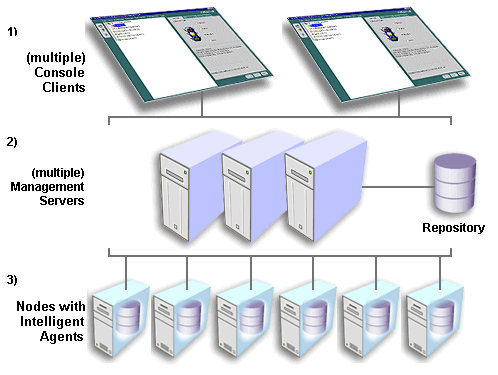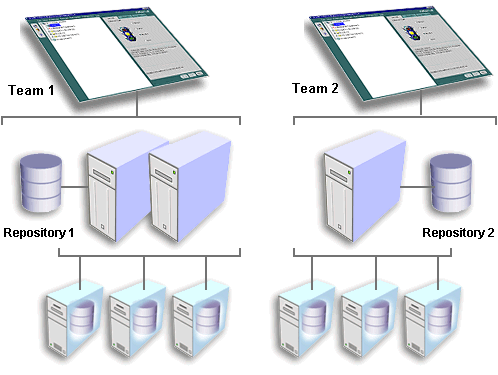Release 9.0.1
Part Number A88769-01
Home |
Book List |
Contents |
Index | Master Index | Feedback |
| Oracle Enterprise Manager Configuration Guide Release 9.0.1 Part Number A88769-01 |
|
This chapter describes key concepts and requirements associated with deploying Oracle Enterprise Manager and its separately licensable Management Packs:
Oracle Enterprise Manager is Oracle's single, integrated solution for administering and monitoring global enterprises. Enterprise Manager is based upon a lightweight, three-tier architecture that offers flexible deployment options, round-the-clock reliability, and unparalleled scalability. The product's three-tier architecture is comprised of the following:
This architecture, which underlies the Enterprise Manager framework, is described in more detail below.

The primary responsibility of first-tier Enterprise Manager clients is to present the user interface to administrators for all their management tasks. Depending on what has been installed and licensed, first tier clients could consist of the following components:
|
Note: Beginning with Release 9.0, Oracle DBA Studio functionality has been fully integrated within the Console. |
|
Note: Oracle Management Pack for SAP R/3 is available on its own CD-ROM in your CD Pack; Pack for SAP R/3 is not installed with the database. |
Because these first-tier Consoles and applications depend upon the second-tier Management Server(s) for the bulk of their application logic, these clients are able to run without the overhead and processing burden of housing critical management services.
The second-tier component of Oracle Enterprise Manager, the Management Server, is the framework engine. The Management Server maintains centralized intelligence and distributed control between clients and managed nodes. It is responsible for all back-end application logic and critical services (i.e. event system, paging and e-mail notifications, reporting, job system, etc.) for maintaining an enterprise.
This middle tier processes requests from first-tier clients, stores the information in a database repository, and distributes tasks for third-tier Intelligent Agents to perform.
The repository also serves as a persistent back-end store where it maintains system data, application data, and the state of managed targets distributed throughout the environment. Data stored in the repository can be shared between any number of administrators accessing one or more Management Servers connected to a single repository.
The third tier in the Enterprise Manager framework consists of managed targets and Intelligent Agents. Managed targets (for example, nodes, databases, web servers, application servers, applications, and others) rely on Intelligent Agents to execute tasks given by the Management Server. Once tasks are assigned, autonomous Intelligent Agents will perform the work as scheduled regardless of the state of the managed targets, Management Server, or clients. Examples of such tasks include executing SQL scripts, monitoring available space in a tablespace, performing weekly database backups, monitoring the real-time database physical I/O rate, or monitoring the availability of the application server.
To offer vital framework functionality the Enterprise Manager architecture can be easily extended on each tier. The first tier allows any number of clients to access one or more second-tier Management Servers. Deploying additional Management Servers provides increased scalability and reliability as well as a choice between grouping the Management Servers together with one repository or dividing them into smaller sets, each set with its own repository. The former configuration allows all administrators to share data contained in the single repository, while the latter offers autonomous units which never interact with each other. Lastly, the number of third-tier managed services and Intelligent Agents can increase with business demands.

Across all three-tiers, the Enterprise Manager architecture establishes the foundation for the robust Enterprise Manager framework.
Enterprise Manager's three tier architecture enables the highest level of reliability and scalability. However, not all enterprises need to implement Enterprise Manager as a three tier system. That is, not all businesses need to deploy each of the three tiers, nor need all companies deploy each tier on a separate machine. Because of the flexibility of Enterprise Manager's architecture, many deployment options are available. Through analyzing your environment, determining your general administrative needs, and careful planning, you can effectively choose the deployment option best suited for your enterprise. Identified below are the available deployment options.
A client/server deployment is one where only the Console and management applications are deployed. Neither the middle tier Management Server nor the Intelligent Agent are installed and used. In this standalone configuration, the client connects directly to the managed target and performs administration tasks.
|
Note: With Enterprise Manager Release 9.0, this type of deployment is only supported against databases. No other target type is currently supported for client/server deployment. |
You should use this type of deployment model if the following conditions apply:
A three tier deployment involves the installation and configuration of the entire Enterprise Manager framework: Console, Management Server/Repository, and Intelligent Agent.
You should use this type of deployment model when you require the following features:
For optimal performance with a three tier deployment of Enterprise Manager, follow these guidelines:
Define Management Regions for large, global deployments or deployments which span a series of WANs and LANs. Management Regions will ensure that cross regional or cross network communication does not occur. In addition, Management Regions allow for mapping nodes across firewall boundaries.
Note: For information on defining Management Regions, a feature introduced with Enterprise Manager release 9i, refer to the Oracle Enterprise Manager Administrator's Guide.
Regardless of the deployment method selected, the following operating system certifications apply to the various components of Oracle Enterprise Manager Release 9.0:
The following components of the Packs listed are not available on any UNIX platform:
If you choose to run Enterprise Manager from a browser, then the following certifications also apply.
After determining how to deploy Enterprise Manager and verifying certifications, ensure that the following system and hardware requirements are satisfied prior to installation and configuration.
|
Note: Hard disk space requirements for FAT Windows-based operating systems could be as much as four times those indicated below. |
|
|
 Copyright © 1996-2001, Oracle Corporation. All Rights Reserved. |
|